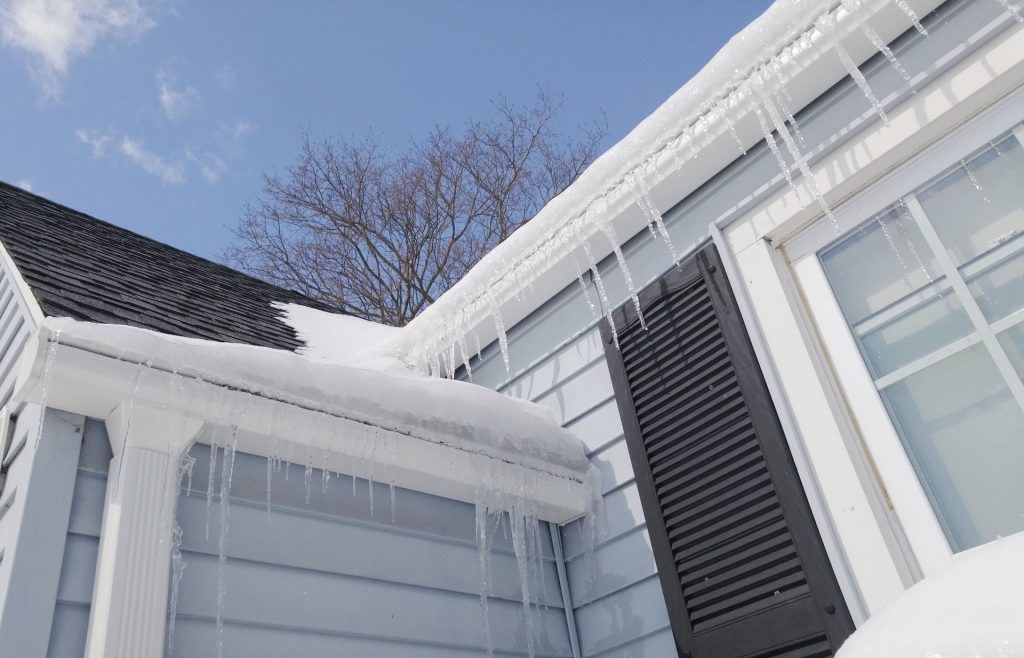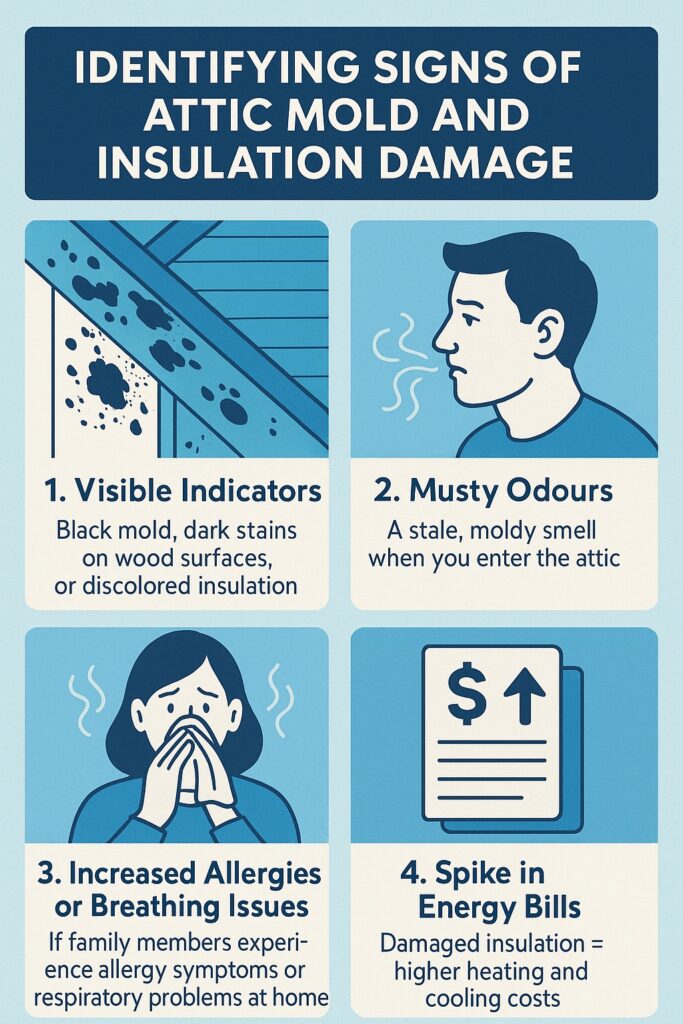
The first question you might be asking yourself is: is attic mold dangerous? Short answer, Yes! Attic mold is a common but serious issue that often goes unnoticed until it causes major problems. Due to moisture buildup, poor ventilation, and fluctuating temperatures, attics create the perfect environment for mold growth. Over time, this toxic mold growth doesn’t just damage insulation—it can lead to structural damage, reduced indoor air quality, and even health problems for your family.
Why Should Homeowners Care?
Mold is more than just an ugly stain or a musty smell. If left unchecked, it can:
- Destroy insulation by trapping moisture and reducing its effectiveness.
- Compromise wooden structures, leading to wood rot and expensive repairs.
- Affect your health, causing breathing difficulties, allergy symptoms, and respiratory problems due to airborne mold spores.
At Above All Insulation, we specialize in attic mold removal services and proper insulation solutions to prevent future mold development. With years of experience, we ensure your attic space remains dry, well-ventilated, and mold-free for the long run. Let go over what you can do to identify and address mold issue in your home.
What Causes Attic Mold?
1. Moisture & Ventilation Issues
One of the biggest culprits behind attic mold is improper ventilation. Common issues include:
- Roof leaks that let humid air and water leaks seep in.
- Blocked or missing roof vents, soffit or eave vents, and ridge vents preventing proper air circulation.
- Bathroom fans or exhaust vents that push moisture buildup into the attic instead of outside.
2. Temperature Fluctuations
Your attic experiences extreme temperature changes, which can lead to condensation and mold growth:
- Warm air rising in winter meets cold attic surfaces, causing moisture problems.
- Excessive moisture leads to mold spores taking hold on wood surfaces, roof sheathing, and fascia boards.
3. Poorly Installed or Damaged Insulation
- Improper insulation can trap humid air, fostering mold development.
- Water-damaged insulation can no longer remain dry, creating a breeding ground for mold infestation.
How Does Mold Damage Insulation?
1. Compromised Insulating Properties
- Mold weakens insulation fibers, reducing R-value and making your home less energy efficient.
- Damaged insulation loses its ability to retain heat, increasing heating and cooling costs.
2. Spread Beyond the Insulation
- Mold in the attic can expand to roof decking, wooden beams, and drywall, leading to structural damage.
- If left unchecked, mold spores can spread through your entire home via air circulation.
3. Health Hazards
- Exposure to mold spores can cause allergic reactions, respiratory symptoms, and serious health issues.
- Long-term exposure to toxic mold can even lead to chronic breathing difficulties.
Identifying Signs of Attic Mold and Insulation Damage
Keep an eye out for these warning signs before mold growth gets out of control:
✅ Visible Indicators: Black mold, dark stains on wood surfaces, or discolored insulation.
✅ Musty Odours: A stale, moldy smell when you enter the attic.
✅ Increased Allergies or Breathing Issues: If family members experience allergy symptoms or respiratory problems at home.
✅ Spike in Energy Bills: Damaged insulation = higher heating and cooling costs.
Quick Self-Check for Attic Mold
🔲 Do you notice a persistent musty smell in your home?
🔲 Are there black or greenish stains on your attic insulation or roof sheathing?
🔲 Have you seen signs of water leaks in your attic?
🔲 Do you or your family have unexplained allergy symptoms or respiratory symptoms?
The Dangers of Neglecting Attic Mold
1. Health Concerns
- Mold exposure can lead to breathing issues, allergic reactions, and asthmatic complications.
- Produce mycotoxins that worsen indoor air quality and cause severe health issues.
2. Structural Damage
- Wood rot weakens fascia boards, roof valleys, and beams, leading to expensive repairs.
- Roof leaks accelerate mold development and insulation damage.
3. Financial Impact
- Mold remediation, attic insulation replacement, and structural repairs can be costly.
- Fixing possible roof leaks early saves thousands in future damage.
Preventing and Addressing Attic Mold Issues
✅ Regular Inspections
- Check roof vents, exhaust vents, and attic insulation at least twice a year.
- Look for signs of moisture buildup and mold growth.
✅ Improve Attic Ventilation
- Install ridge vents, eave vents, and soffit vents to regulate air circulation.
✅ Repair Roof Leaks Promptly
- Small water leaks can quickly lead to mold infestation.
✅ Use High-Quality, Moisture-Resistant Insulation
- Spray foam insulation or fiberglass with vapor barriers prevents excessive moisture buildup.
✅ Apply Mold-Resistant Coatings
- Protect wood surfaces with mold-resistant treatments.
Professional Mold Remediation and Insulation Services
DIY vs. Professional Mold Removal
- Dry ice or soda blasting are effective but require expertise.
- Professional services ensure complete removal and prevent regrowth.
What to Expect from a Pro?
✔ Mold inspection to assess the severity.
✔ Safe removal and disposal of contaminated materials.
✔ Proper insulation replacement and moisture prevention solutions.
Why Choose Above All Insulation?
- Years of experience in attic mold removal and insulation services.
- Guaranteed workmanship, thorough inspections, and reliable follow-ups.
Cost Considerations and ROI
Initial Investment vs. Long-Term Savings
- Investing in proper insulation and mold remediation leads to lower energy bills.
Factors Affecting Price
- Square foot size, severity of mold infestation, and type of insulation needed.
Insurance & Financing Options
- Some insurance policies or financing options may cover mold removal and insulation replacement.
FAQs
1. How quickly can attic mold spread?
Molds grow extremely fast—within 24-48 hours in damp conditions.
2. Are all black stains in the attic mold?
Not necessarily, but air quality testing by a professional can confirm.
3. Is attic mold removal dangerous?
Yes, handling a mold problem incorrectly can spread mold spores throughout the home.
4. Do I need new insulation after mold remediation?
Heavily infested insulation must be replaced.
Attic mold isn’t just an eyesore—it’s a serious threat to your home and health. From damaged insulation and higher energy bills to structural issues and respiratory problems, ignoring mold growth can lead to costly repairs and health concerns. The good news? You can prevent and fix it with the right approach.
If you suspect attic mold or insulation damage, don’t wait for the problem to spread. Above All Insulation specializes in mold inspection, attic mold removal services, proper insulation solutions, and moisture control, ensuring your attic space remains dry and energy-efficient.
Call us today for a free estimate or schedule an inspection—your home (and your health) will thank you! Prevent mold growth—don’t let your attic become a science experiment—sort out that mold and protect your home before it becomes a major problem.
